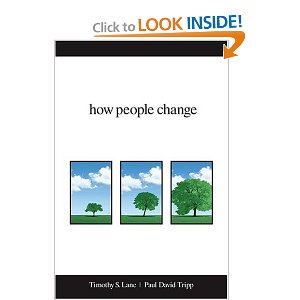 One of the perks of blogging is the constant stream of new books that come in the mail. Most of the time, publishers ask me what books I am interested in reviewing. Some publishers send unsolicited manuscripts. Because of time constraints, I leave most unsolicited books on my bookshelf.
One of the perks of blogging is the constant stream of new books that come in the mail. Most of the time, publishers ask me what books I am interested in reviewing. Some publishers send unsolicited manuscripts. Because of time constraints, I leave most unsolicited books on my bookshelf.
But recently, I received How People Change (New Growth Press, 2008) – a new book by Paul David Tripp and Timothy Lane. Intrigued by the cover and the contents, I took the book with me to Moldova. It’s a good thing this book didn’t get put on the shelf. How People Change
is one of the best books I’ve read this year.
Tripp and Lane believe that the biggest area lacking in Christian counseling today is the gospel. They call this problem the “gospel gap.” Too many Christians see the gospel as affecting their past (forgiveness) and their future (hope), but do not understand the practical ways in which the gospel should be brought to bear on their present choices. How People Change seeks to correct “the gospel gap” by providing biblical teaching and and practical instruction.
The opening chapter alone is worth the price of the book. Tripp and Lane believe that our temptation is to seek fullness and fulfillment in something or someone other than Christ. To counter this idolatry, they encourage us to apply the grace of Christ to the everyday details of our lives, not merely the big problems that we face. The rest of the book spells this theme out more clearly – how to apply grace to everyday life.
How People Change avoids moralism. It centers the gospel message, not in abstract terms, but in the story of redemption. Tripp and Lane are big on seeing the gospel within the framework of the biblical Story. They write about the Christian’s past and the Christian’s future in order to shine light on the Christian’s life in the present. Our destination informs our journey.
There are a couple of places where I believe the theological language could be a little more refined. In describing Jesus’ crucifixion, the authors write: “The triune God was torn asunder so that we might be united to him and to one another as brothers and sisters in Christ.” (69) They interpret Jesus’ words on the cross this way: “Why have we been ripped asunder?” I understand the loss of covenant fellowship between Father and Son at the cross. Yet, I am not comfortable with the language that the “perfect unity” that existed between the Trinity being demolished, if even for a time. Do not most theologians see all three members of the Trinity as united in the task of redemption? The authors’ description lends itself to the idea that God could somehow be split in his essence and is not careful enough for me.
Another weakness is in the chapter: “Married to Christ.” The authors choose to describe individual Christians as being married to Jesus (betrothed is the word they use). But they bypass the church in this chapter. Instead of seeing our marriage to Christ as taking place within the fuller community of faith, they skip the church and talk about the individual being married to Christ. To their credit, by the end of the chapter, they switch the emphasis. In the next chapter, they turn to the community of faith and spend a good amount of time on sanctification within the body of Christ. The rest of the book maintains the right emphasis upon the individual within the context of covenant community. Perhaps that is why the marriage chapter seems out of place. Nowhere does the Bible speak of the individual as being the bride of Christ.
The second half of the book focuses on Heat, Thorns, Cross, and Fruit.
- Heat represents the circumstances of life that are beyond our control.
- Thorns represent those areas of sin that we are easily entangled in.
- The Cross represents the resources that Christ gives us in our sanctification.
- Fruit represents the outworking our growth in holiness in tangible ways.
I like the way the authors make their case. One of the secondary themes that runs throughout this book is a primary emphasis in the book I am writing for Crossway: we take good things and make them ultimate things. We engage in idolatry whenever take something out of its proper sphere and put it in a place of worship.
How People Change rightly roots our problem in idolatry, not in our lack of self-esteem. We are idolaters at heart. Therefore, the issues must be dealt with at the heart-level.
The authors state their vision for this book:
“Our desire is to see individual Christians and entire churches participate in a ground swell of gospel celebration – a celebration of the amazing grace available to us in Christ.”
I believe How People Change is a book that can help churches move in the direction of fulfilling this vision. It is relentlessly biblical, immensely practical, and pastorally helpful. I highly recommend it.


















